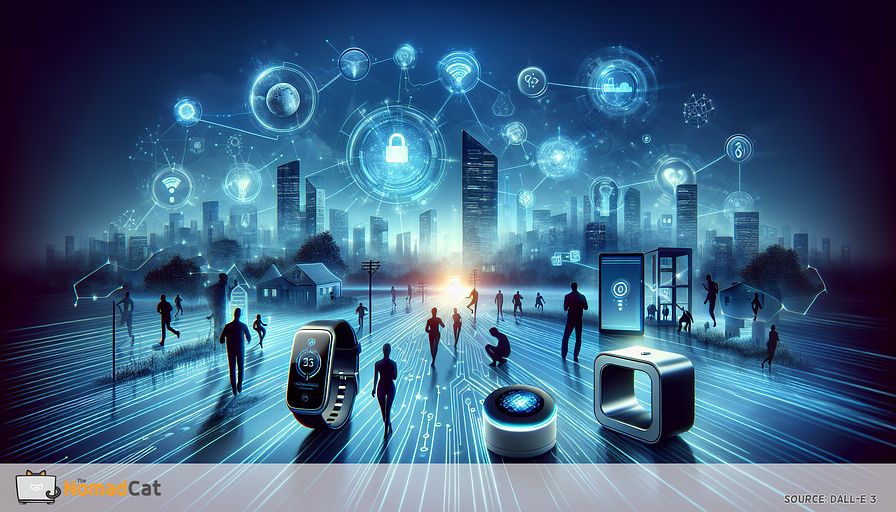Abstract:
The advent of smart devices is transforming our daily activities, from how we manage our homes to enhancing personal health and productivity. These devices, ranging from smartwatches that monitor our health metrics to smart home systems that allow for remote control of lighting, heating, and security, are becoming integral parts of our lives. The proliferation of the Internet of Things (IoT) technology is the backbone of this transformation, offering seamless connectivity and integration of devices for a more intuitive and automated lifestyle. For technology leaders like Directors of Technology and Chief Technology Officers, understanding the potential and challenges of smart device integration into existing systems is vital. This not only requires a grasp of the technology itself but also a strategic vision for its implementation to improve efficiency, security, and quality of life, positioning their organizations at the forefront of this significant technological shift.
Revolutionizing Daily Life with Smart Devices
Picture waking up to the gentle vibration of your smartwatch, which has calculated the optimal time for you to rise based on your sleep cycle. As you get out of bed, the lights in your room brighten gradually, synced to your personal preferences through a home automation system. While you brew your morning coffee, your refrigerator, noticing you’re low on milk, adds it to your shopping list, and maybe even places an order online. Fast forward to the evening: a simple voice command to your smart speaker turns down the lights and draws the curtains, wrapping up your day just as seamlessly as it began. This scenario, which might have seemed like science fiction a decade ago, is today's reality thanks to the proliferation of smart devices.
The integration of the Internet of Things (IoT) technology into everyday items is not just about adding convenience but also enhancing efficiency, bolstering security, and elevating our quality of life. Devices such as smartwatches track our health metrics, while smart security systems ensure our homes are monitored around the clock. But it’s not all smooth sailing: the implementation of these technologies presents substantial challenges, from ensuring data privacy to managing interoperability among devices. As a Chief Technology Officer, I am deeply involved in finding innovative solutions to these hurdles, striving to optimize how these devices integrate into our lives.
The impact of this technological integration is profound, affecting not only individual lifestyles but also how we manage and interact with our environments. What follows will be a more detailed exploration of how as technology leaders, we can strategically address and navigate these challenges to fully harness the potential of smart technologies. Join me as we explore together, learning not only to manage but also to thrive in this connected world.
Strategic Implementation and Challenges for Technology Leaders
The Vital Role of Technology Executives in Smart Device Integration
As someone who orchestrates technology strategies daily, I understand the weight of responsibility on technology executives, like Directors of Technology and other such roles, to seamlessly integrate smart devices within existing systems. We often act as the bridge between innovative technologies and operational efficiencies, striving to mold these tools into solutions that not only enhance productivity but also improve the quality of life for our users.
In this era of relentless innovation, one of our key roles is to craft strategies that ensure new smart technologies harmonize with our existing infrastructure. This balances act involves enhancing security protocols—which is non-negotiable in safeguarding sensitive data—and optimizing operations to achieve peak efficiency.
Examples from the Field: Success Stories and Innovative Approaches
Consider a case where a renowned retail corporation integrated smart inventory management systems across all its warehouses. This strategic decision led to a dramatic reduction in manual errors and a significant boost in supply chain efficiency. Another example is a healthcare provider that incorporated IoT devices for monitoring patient health remotely, thus enhancing patient care and operational robustness.
These examples underline the transformative impact of strategic investments in smart technology. They showcase not only cost reductions and efficiency improvements but also accentuate the potential for these technologies to redefine user interactions and organizational workflows.
Overcoming the Complex Challenges
Yet, the road to successful integration is paved with challenges. Data privacy stands out as a paramount concern, given the expansive data collection capabilities of IoT devices. As guardians of this data, our duty extends beyond mere compliance with regulations; we must proactively champion secure and ethical data management practices.
System compatibility is another hurdle. The dream of having a fully integrated smart environment often clashes with the reality of heterogeneous systems that struggle to communicate. Achieving interconnectivity requires meticulous planning and often, substantial investment.
User adaptability also plays a crucial role. No matter how technically perfect a system may be, its success ultimately depends on the end-user’s willingness and ability to adopt and adapt. Thus, part of our strategic planning involves comprehensive user education and support systems to ease this transition.
Moving Forward: Innovation as a Continuous Mandate
Looking ahead, the onus is on us, the technology leaders, to perpetually innovate and refine our approaches to stay competitive in an IoT-driven marketplace. This involves not only following the current trends but also predicting future developments in smart technology.
We need to continuously analyze the landscape, test new ideas and learn from each iteration. It’s a bit like being a gardener; you prepare the soil (infrastructure), plant the seeds (technology), and nurture them (strategic management) to reap the fruits (successful integration).
Smart devices are no longer just gadgets; they are integral tools that assist in painting the bigger picture of digital transformation. As we move forward, let’s remember, it's not just about technology; it's about crafting enduring solutions that resonate with and enrich human experiences. Let’s harness these smart technologies wisely, to not only achieve, but exceed our strategic goals.














